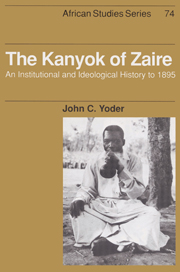Book contents
- Frontmatter
- Contents
- List of maps and figures
- Acknowledgments
- Abbreviations
- Chronology
- Introduction
- 1 Wood and wine, gardens and game
- 2 Stratification, symbols, and spirits
- 3 New legends for new leaders
- 4 Serpents and lightning
- 5 Dances, moats, and myths
- 6 Combat, classes, titles, and trade
- 7 Schisms and slaves, ghosts and guns
- 8 Assassinations, alliances, and ambushes
- APPENDIX: Methodology
- Notes
- Bibliography
- Index
- Titles in the series
3 - New legends for new leaders
Emergence of patrilineally controlled chiefdoms, ca. 1500 to 1700
Published online by Cambridge University Press: 29 September 2009
- Frontmatter
- Contents
- List of maps and figures
- Acknowledgments
- Abbreviations
- Chronology
- Introduction
- 1 Wood and wine, gardens and game
- 2 Stratification, symbols, and spirits
- 3 New legends for new leaders
- 4 Serpents and lightning
- 5 Dances, moats, and myths
- 6 Combat, classes, titles, and trade
- 7 Schisms and slaves, ghosts and guns
- 8 Assassinations, alliances, and ambushes
- APPENDIX: Methodology
- Notes
- Bibliography
- Index
- Titles in the series
Summary
During the sixteenth and seventeenth centuries the Kanyok, along with other people living on the southern savanna, experienced profound changes in their political, ritual, mythological, economic, family, and military life. These changes resulted in part from the accumulation of inevitable adjustments all societies make as they adopt a more sedentary existence, but outside forces and products, some from as far away as the Americas, also made this a time of transition and innovation. While the Kanyok and many of their neighbors had once been organized in small-scale matrilineal polities, by the end of the seventeenth century, ambitious patrilineally oriented big men gained control of most villages and regions. (See Map 3.) Not only did the big men dominate military, political, and economic life, they or their supporters also transformed the rituals and legends which legitimized and perpetuated the new leaders in office.
New wealth, population growth, and insecurity
Evidence from surrounding peoples indicates that by 1500 the pace of local and regional commerce had quickened and that important centers for the production or exchange of traditional African products such as iron, salt, palm nuts, palm oil, dried meat and fish, and even copper had emerged across the southern savanna. Before 1700, Kaleng a Mukel, a Kanyok region rich in palm groves, was known for the manufacture of salt. (See Map 4.) At Kaleng a Mukel, ash from burnt grass and palm branches was leached with water to produce a brine which was then boiled or allowed to evaporate until a form of salt remained.
- Type
- Chapter
- Information
- The Kanyok of ZaireAn Institutional and Ideological History to 1895, pp. 29 - 50Publisher: Cambridge University PressPrint publication year: 1992



